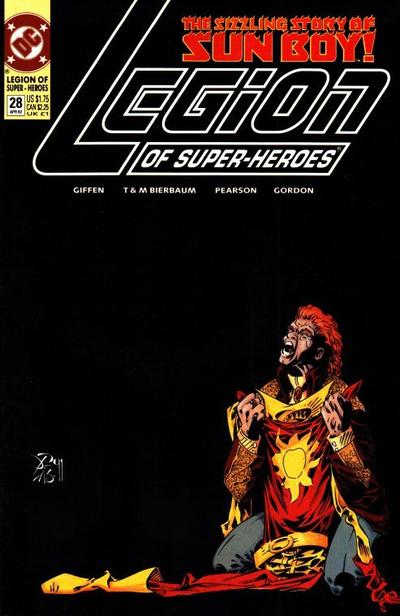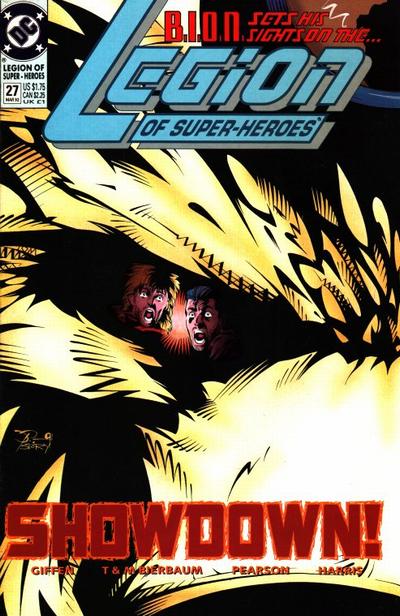Legion sales data talk part 2: mid-1980s to today
In part 1 of this sales discussion, I primarily focused on the early days, from 1960 to the mid-1980s, and the problems we have with determining sales data after that. In this part, we pick up in the mid-80s and go all the way to today.
Over in one of the Facebook groups, I was in a discussion that started out asking "why was the Reboot cancelled to make way for the Threeboot?" The answer, usually, is sales. But that's not the whole answer here. I looked at my sales data, made some plots, and I'll re-present them here.
First, here's an overview of the sales of all the various Legion books from January 1997 to December 2008. Abnett & Lanning took over in early 2000, and the Threeboot started in early 2005. The Threeboot ends a few months after the right side of the graph, you can see "Legion of 3 Worlds" coming in at the top right corner.
By early 2000, when Abnett & Lanning came on as writers, sales for both "Legion of Super-Heroes (v4)" and "Legionnaires" had bottomed out at about 17,200 copies. Sales rose through "Legion Lost", "Legion Worlds", and "The Legion", and when "The Legion" was cancelled it was selling 23,300 copies. You can see the slow but steady rise from series to series, which is practically unheard of. Four years later, the Threeboot was down to where sales were when the Reboot ended. Or, in other words, sales on "The Legion" were up by 35% from their lowest point five years earlier when the book was cancelled.
So sales couldn't be the ONLY answer.
Then I was asked if I had the data as far back as the end of the Levitz run ("LSH v3") in 1989. The answer to that is complicated and "yes, but...."
I have all the data back to the Adventure days. However, there are some huge caveats to the data that is publicly available, and has to be mentioned before looking at this time frame:
- Up through 1985, the only thing available was the statement of ownership, which listed the average number of copies sold in the past 12 months, so there's no individual issue data.
- From May 1985 to October 1994, DC was using both Capital Cities and Diamond as their main distributors (there were others in there too), but only the Cap Cities data is available. There is an approximate number that is then applied to project CC data to total sales: while it’s great to know that in 1986 they had 9.1% and it jumped to 15.5% in 1987, that’s not necessarily a flat rate for every title every month of that year, and since we only have annual data, that messes up the plot between the December and January data points. Also, I only have that percentage factor up through 1988, I don't know what percentage of the market CC had from 1989 to October 1995. In Fall 1995, Capital Cities went out of business when everyone went exclusive with Diamond (part of the Marvel/Heroes World fallout).
- From Nov 1994 to Oct 1996, we have the "index/key" from Diamond, where sales were noted as a percentage of how many copies of that month's issue of Batman. Just picking one issue at random, LSH #78 in March 1996 sold 33.0% of the number of copies of that month's Batman. That's the index. The key is 660 (they look at the sales of "Batman" and determine that one index point equals 660 copies), so if you multiply 33.0 x 660 you get 21,870 copies distributed by Diamond to stores. But it's not even quite that easy:
- I asked John Jackson Miller, "From 11/94 to 10/95 cover-dated issues, the book has CC pre-orders and the web has a Diamond index & key (to figure out Diamond’s pre-orders). Do I add those together to get that month’s sales?" He replied: "It'll give you a minimum level for Direct Market sales, but will leave out the nine or ten other smaller distributors to comics shops, plus what was sold to the newsstand. The figures will still be low by a good deal."
- To which I replied, "Can you ballpark quantify "a good deal" - something like I should add 10%, 20%, 30%, etc.?" His answer: "It depends on the book. Did it have newsstand circulation, or was it direct-only? Diamond plus Capital probably was north of 50%, possibly 60% of the DM as we approached 1995. Newsstand -- just a guess, but probably another 15%."
- From Nov 1996 to May 2005, Diamond gave "pre/final orders" as a straight number of copies.
- From June 2005 to present, Diamond reports the final orders. I'm not sure what the difference is.
All of my data comes from comichron.com, and they are slowly uncovering and posting data from the late 80s through mid 90s which I currently don't have.
When I plot out the data from 1988-2005 (end of v3, 5YL through the Reboot, and Reboot up to the Threeboot), it's obvious that there's missing data from 1989-95. Right now I have random issues with both CC and Diamond data, those look like spikes and I'd say they are more or less trustworthy. But don't read any numbers into issues where it shows less than 35K sales, that's just not valid. You can maybe read general trends, but that's about it. The heavy dashed line is just a straight line connecting the last good data point from v3 in 1988 with the next known good point in 1995, and you can see that it basically keeps up the trend until 2000. That dip you see from 1995-97 is due to how Comichron has the data from Diamond, before 1997 was when they used the key/index system and after that it uses pre/final orders. If nothing else, it suggests that maybe the key/index system has errors that undercount sales. This is why I started the top plot from January 1997, to avoid all of that which we can see in this plot.
Then someone pointed out that "one thing stands out and that's all major upheavals to the Legion produce short-lived boosts with the book returning to its baseline sales after a while." I hadn't thought to plot it that way before, but here's a look at all of the series since the Zero Hour reboot, organized by sales by issue number.
Of note: only 4 series dropped below 15k: "Star Trek/LSH" and "Legion Secret Origin" (both limited series) and the two ongoing New 52 series "Legion Lost v2" and "LSH v7". "Adventure Comics" and the two Reboot series prior to A&L, "Legionnaires" and "LSH v4", dropped below 20k. The spike in "LSH v4" with issue 86 has to do with how Diamond reported their numbers, it's not a true sales jump. That's what we saw above from 1995-1997 (and you can see it in the "Legionnaires" series too).
At this point, you can see that the current series is already doing better than the two New 52 series by 5-10K copies, so that's a big win. But look how flat "The Legion" is there, hovering right around 25K the entire run (the jump is when Superboy joins).
What does it all mean?
- Well, for the most part, if you drop below 20K that's not good news. But it also shows that reboots wear off within a year or so, and you just try to maintain what you have.
- Crossovers raise sales (Final Night, Blackest Night, The Culling) but that's typically not sustained.
- A new #1 is good for really high sales but that quickly goes away within the first few issues.
- Superboy ("The Legion") or Supergirl (v5) joining gives a sustained sales bump, but doesn't stop the slide.
- A rise in sales, or even flat sales over several years, isn't necessarily going to prevent the book from getting cancelled.
- And it's been a long time since a Legion title lasted beyond issue #50.





















